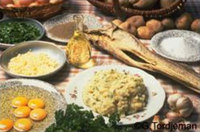Discover a Lot Valley speciality: The Estofinado

It is more than a dish, it is the whole story of the Lot river you will find in your plate. Based on stockfish (dried unsalted cod) that the Nordic boatmen brought with them when they used to transport goods along the Lot in the 18th century.
The name Estofinado comes from the “estofi”, literally “fish stick”, in reference to the fish which is as hard as wood once dried.
To make a good 'estofinado', you definitely need Lofoten Isles stockfish, of premium quality. Cods are caught during the winter when they migrate to Norway to spawn. The fish is not salted but it is set to dry on racks in the open air, in the sunshine and the icy cold. The polar weather gives the stockfish its special flavour then! With such a special drying process the fish contains more calories, proteins, phosphorus and calcium than any fresh or salted cod.
In the 18th century, Bordeaux was a big market place for the cod trade and the fishmen used to take the dry fish back to the Lot Valley, hanging it at the front of the gabarre , bathing in the river, it was then arriving rehydrated and perfectly tender for consumption! Cheese, wood, coal, wheat, etc. were conveyed by boat on the river Lot that had been navigable since the Middle Ages. Boatmen then brought back salt, spices and stockfish from the harbour of Bordeaux.
This is why you can only find the Estofinado in the Lot Valley, near the river, in the Aveyron département. You can't find it in other parts of the département. In Decazeville, during the prosperous mining period, the Estofinado was the miners' emblematic dish.
Today, if you want to try this very local speciality, go to Almont les Junies, the capital of Estofinado, in the only remaining restaurant of the village.
In his restaurant in Laguiole, Michel Bras, the 3 Michelin stars chef, offers a subtle variation of the recipe with wild herbs.

